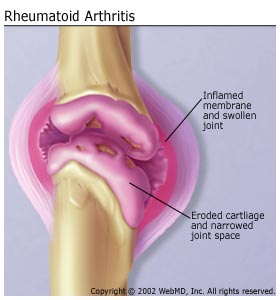
Rheumatoid Arthritis
Rheumatoid Arthritis or Amavata is a joint disorder which effects peripheral joints (hip, knee, ankle, wrist, shoulder, temporomandibular, etc). It is caused by an accumulation of Ama (this is produced when Agni (Enzymes responsible for digestion and metabolism) does not function properly) and vitiation of the vata dosha.
Causes:- Amavata is caused by:-
- Unwholesome food:- It aggravates production of Ama in the body.
- Excess physical activity immediately after taking unwholesome food. It vitiates Vata as well as Ama production.
- Seasonal changes:- During transition from one Season to another. The digestive power of a body is at its lowest.
- Ageing process:- After the age of 40-50 there is an increased proportion of Vata dosha in body and the digestive system is also weak.
- Emotional factors such as excitement, grief, anger, fear etc. also responsible for Amavata.
Symptoms:- The disease first appears with following symptoms:-
- It starts with stiffness in the body when one gets up in the morning.
- One gets tired very easily.
- One may have constipation or irregular bowel movements.
- Pain and swelling in peripheral joints. In the beginning all these symptoms are very temporary in nature. However, in the later stages, swelling and pain of the joints begins to persist. The process is so gradual that the patient often does not even get the faintest idea that she is going to be a prey of a chronic disease. One keeps taking symptomatic medicines, meanwhile, the disease continues to get worse.
- Gradually along with pain, deformation of the joint (flexion: the bending of a joint so that the bone forming are brought towards each other) make the patient completely unfit to do any work.
Treatment:–
- Nidan Parivarjan:– Removal or avoiding the causes of the disease.
- Pathya Sevana:– Changing the lifestyle and diet to facilitate the cure:-
- a)Pathya Ahara (The right food):- Whole wheat, pulses ( moong and masoor), pumpkin, bitter gourd, spinach, ginger, garlic, vegetables with high water content, cucumber, beans, Red rice etc., because these are easily digestible and do not produce gas.
- b)Pathya Vihar (The right lifestyle):- Light exercises and yoga help ( it does not aggravate vata)
- Shamana (Ayurvedic Medicine therapy):– This usually follows elimination of vitiated doshas from the body. In acute phases of the disease, when there is production of Ama, medicines given to digest the Ama. The usual medicines administered are:
- Amritotharam Kashayam
- Pippalyasavam
- Dasamoolarishtam
- Ajamodadi Choornam
- Shunthi Choornam
- Shodhana Chikitsa(Ayurvedic PanchakarmaTreatment):- Elimination of vitiated doshas from thebody.
- a)Langhan (Fasting):- It may be complete or partial, depending on the strength of patient, place and season. It normalizes irregular bowel function.
- b)Virechana:- Medicated purgation therapy, Ama is eliminated from the body and bowels are also cleansed.
After complete digestion of Ama, if pain and swelling still persist then a course of the following is given:-
- Shamana
- Valiya Rasnadi Kashayam
- Guggulutiktam Kashayam
- Balarishtam
- Punarnavadi and Gukshuradi Guggulu
Shodhana:–
- Vasthi:– It is also known as medicated enema, highly beneficial in cleansing and detoxifying the body.
- Prizhichilor oil bath therapy:- highly rejuvenating treatment. It increases blood circulation and enhances muscular tone.
- Elakizhi:- Also known as herbal Potli treatment, it promotes better circulation, increases perspiration which helps skin to eliminate the toxins and improve muscle tone.

